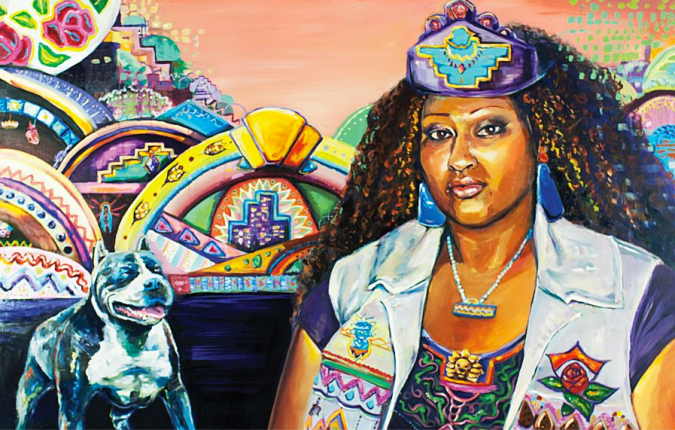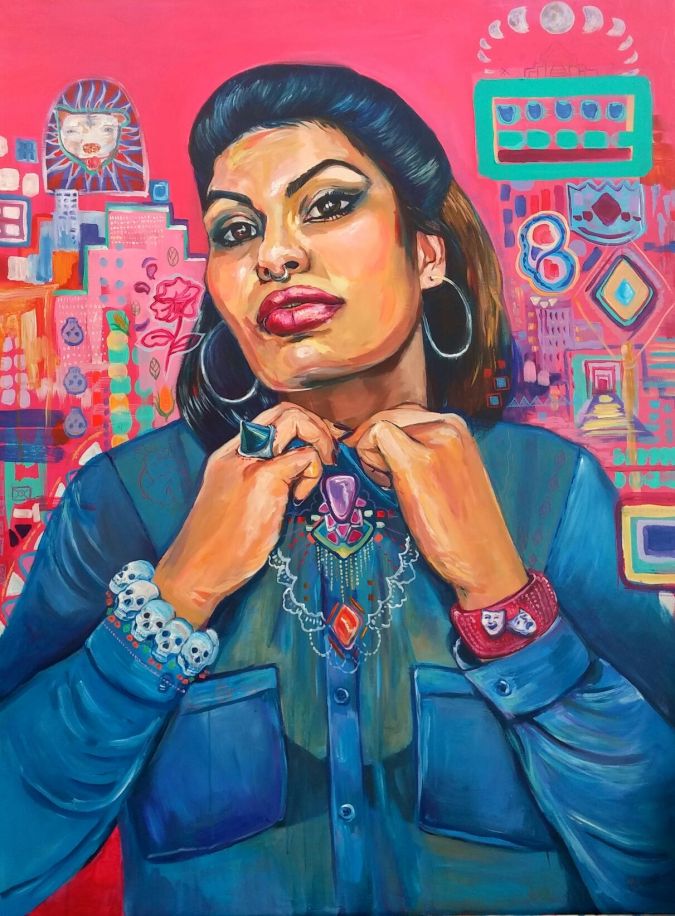Chicanas, chingonas, and cholas deified as fierce queens glare down from the canvas in Crystal Galindo‘s paintings. The rainbow of brown women depicted in her oeuvre are not your typical portrait subjects. They’re artists, immigrants, and activists with an air of nobility, bedecked with beaded jewels in indigenous designs and necklaces of human hearts – similar to the one worn by Aztec goddess Coatlicue. Galindo’s work goes beyond traditional depictions of the muse as an airy waif. She instead portrays resilient women who put their culture at the forefront.
With crowns of sugary pink conchas and headdresses of mazapán as her jeweled tiaras, Galindo’s self-portraits are also a political act of cultural inclusion. In the age of the front-facing camera, where many people are beginning to see selfies as political and aesthetic acts of resistance, her portraits are bestowing power on a different crop of women. They’re on par with the idea behind #XicanaDaily Instagram posts on @Xicanisma_ , where reposted selfies are designed to celebrate of brown woman aesthetics.
In the last few years, Galindo has been on her hustle creating new work out of Oakland, sending off paintings to galleries across the U.S., and even doing her own curating. She curated the show Muxeres at El Comalito last October, the same month she gave birth to her daughter Iyari, whom she calls her pan dulce cósmica. Last March, the two were used as models for a mural painted at Facebook headquarters by muralist Jessica Sabogal.
I truly believe that selfies are so much more than a shallow, narcissistic tool.
While Galindo has begun finding a captive audience for her work via social media and small shows, her style of painting wasn’t always accepted. She had it tough while getting her studio arts degree from Sonoma State University, where her classmates’ critique of her work was that it reminded them of bad Mexican paintings. “They remind me of being drunk in Mexico,” they’d say. “You need to stop painting yourself. Are you trying to be Frida?” She says there were times she wanted to give up. Not until she began showing in pop-up shows and small galleries did she receive feedback from women who saw themselves in her work. “People told me my work made them feel empowered and beautiful. So I told myself I’m going to keep going because our stories need to be told. That’s more important than somebody telling me they can’t relate because they’re privileged,” she said.
Galindo spoke with me about the political elements of her work and how diversifying images in our visual landscape is so important.
With the subjects of your paintings as cholas, indigenas, Chicanitas, chingonas, and black xicanas, you really define the multiplicity of what a Xicana is. Can you talk about what you believe encompasses the Xicana experience?
If I were to speak broadly about it, I think that we’re navigating multiple worlds. It’s not just navigating two. It’s not just the ‘ni de aqui, ni de alla’ mentality. To say my history, my heritage, my culture, my ancestors are from the other side of the border, but I was born and raised on this side: I think it’s more complex than that. There’s so many different identities. Like do you speak Spanish or do you not? Do you identify with colonization or do you want to decolonize and reclaim your roots? In that sense, I think there is a struggle to reconnect and reject even the colonialism that exists within Mexican culture.
Can you give me the background story for your painting ‘Black Xicana Queen’?
My sister and I grew up in a small town of predominantly Chicanos, indigenous Mexicans and a lot of white people. We didn’t really have a lot of diversity in our schools and with our peers. I knew she always felt different. I decided that I wanted to paint her not to tokenize her struggle but to celebrate her and give her the platform she deserved. I wanted to address in a proud way that she has overcome the type of racism that exists in our community. Not only is she a black queen but she’s a Xicana queen too. That’s something people where we grew up did not understand. I think within our community there is a lot of anti-black racism that people like to ignore or normalize, and I think it’s time to speak on it and hold people accountable. I think that painting has sparked those type of conversations.

Let’s talk about the selfie. Do you believe selfies have a bigger symbolic meaning, maybe some sort of political element?
I truly believe that selfies are so much more than a shallow, narcissistic tool. I see it all the time on social media where people are calling other people out saying, “put the phone down, stop talking selfies, worry about something else,” or “all these selfies and no knowledge of self.” It’s coming from a misogynistic standpoint. I think selfies are combating the stereotypes and ideas that society has put upon us that we have to fit some sort of mold to be beautiful. It is totally amazing to combat the idea of Eurocentric whiteness as the pinnacle of beauty by taking a selfie and posting it. In doing that, we are letting the world know: “I think I’m beautiful. I think I look fine as hell today, and I don’t care what you think of me.” It creates a sort of camaraderie among people of color. We appreciate each other. We can uplift each other with that and we can love ourselves despite what society thinks we should look like or how we should behave.
Representation matters. When you see yourself in works of art or on TV it helps you to realize that you matter.
You explicitly say you do not identify as Latina, Hispanic, and do identify as Yaqui/Xicana. Can you explain why you don’t identify as Latina/Hispanic?
Growing up, I didn’t think that people would understand what Yaqui or Xicana meant. As I started to gain more confidence in myself and learn more about the complexities of colonization, assimilation, and cultural genocide, I decided I didn’t want to label myself in a way that would give credit to colonization or those that oppressed me for my identity. There’s more under the surface than that. Using those all-encompassing terms can be almost dangerous to our identity. It can whitewash us and strip us of our indigeneity. I felt that’s what it was doing to me. It was stripping me of my indigenous pride and roots.
Why do you have to explicitly put on your Tumblr, “I do not consent to porn, fetish or nude blogs reflagging me or my work?” Is this the down side, problematic part of social media?
Social media has its quirks. People feel like they know you in a more personal way than they should. It makes way for people to slide into your DMs, especially patriarchal men feeling the need to message me, to hit on me, or to try to tell me that what I’m doing is wrong because they feel for some reason that being empowered as a woman is offensive to men and families. They tell me I have a child, so I shouldn’t be on social media showing cleavage. It’s usually people who at first try to talk to me in some sort of sexual way. I’m in a monogamous relationship so I feel the need to shut that down right away.

The fact that I have to put that message on Tumblr is indicative of how a lot of men see our selfies and photos as a means of consumption. For me, it doesn’t matter if it’s a picture that’s a full body or if it’s from the neck up, the photos get reblogged, and I start to get unsolicited dick pics. It’s a means of harassment that I don’t think anybody deserves. To shrug our shoulders and to say, “that’s just men” feeds into a type of culture where women always have to be on guard and we are blamed for the things that happen to us in that way– the catcalling, the harassment online. Ultimately, we’re see as less than human because we’re here for male consumption and were disposable.
I think I would be doing a disservice to the body positive movement to not discuss how your work is a celebration of women who challenge beauty ideals. The women you paint are forces of nature.
I don’t just choose to paint people who are beautiful. Even though they are beautiful to me, it’s something that is secondary. I choose them because of the feeling I get from being around them or seeing them on social media. Especially with the next series ‘Chingones.’ I’m not thinking, “Oh I have to choose someone because they have this body type and they’ll look good in a work of art. It’s more like, “Wow this person has persevered. They’re doing their thing and I’m really proud of them, and I want to paint them.” I end up painting this whole spectrum of women who don’t always fit the beauty standard. We’re creating this whole different side to beauty that is representational of us. Representation matters. When you see yourself in works of art or on TV it helps you to realize that you matter. If you look around and don’t see anyone that looks like you or reflects a similar background or body type or awkwardness, it makes you feel isolated and that you shouldn’t exist. Representation is crucial to helping others accept themselves and love themselves.




